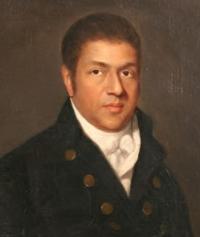 As Black History Month comes to a close, it is worthwhile to remember early African-American shipmasters. Who was the first? That is hard to say. Paul Cuffe is a good candidate.
As Black History Month comes to a close, it is worthwhile to remember early African-American shipmasters. Who was the first? That is hard to say. Paul Cuffe is a good candidate.
Paul Cuffe was born on Cuttyhunk Island, MA on January 17, 1759, the seventh of ten children of Kofi or Cuffee Slocum and Ruth Moses. His father, a freed black man, was a member of the Ashanti people of Ghana. His mother was a Native American of the Wampanoag Nation of Martha’s Vineyard. Cuffee Slocum was a skilled carpenter, farmer, and fisherman, who taught himself to read and write. In 1766, Cuffee Slocum was able to purchase a 116-acre farm in Westport, Massachusetts.
Paul Cuffe went to sea at 16 on whalers and merchant ships, where he learned navigation. During the American Revolution, his ship was captured by the British and Cuffee was imprisoned for three months in 1776 in New York. He returned home to Massachusetts and in 1779 built an open boat which he used to run the British blockade, bringing trade goods to Nantucket and ports on the Massachusetts coast.
He built up a small fleet of open boats and then moved on to schooners. His first seagoing vessel was the 15-ton Box Iron, followed by a 25-ton schooner, Sun Fish, and the 40-ton schooner Mary. By 1796, Cuffee built Ranger, a 69-ton schooner in his shipyard in Westport. By 1800, Cuffee purchased a half-interest in the 162-ton bark Hero. In 1806, he had the 109-ton brig Traveller and 268-ton ship Alpha built. By the early 1800s, Paul Cuffe was one of the most wealthy men of color in the United States.
In addition to his maritime activities, he was also politically and socially active. His petition to protest taxation of people of color while withholding the right to vote was an important step in granting full citizenship rights in Massachusetts. He established the first racially integrated school in Westport, Massachusetts and was a vocal abolitionist. Cuffee was also an early proponent of the “Back to Africa” movement, a topic he discussed with President James Madison, becoming the first black men to have a formal meeting with a sitting U.S. president.
Today, the Paul Cuffe Farm in Westport is a National Historic Landmark and the Paul Cuffee School, a maritime charter school in Providence, Rhode Island, is named in his honor.
Captain Paul Cuffe Park at the corner of Johnny Cake Hill and Union Street in New Bedford, MA was expanded and re-dedicated on September 21, 2018. The New Bedford Whaling Museum currently features an exhibition, Captain Paul Cuffe: His Work, Vision, and Living Legacy.

Fascinating! Thanks for sharing this tribute.
That’s a fine portrait– gifted artist. And a truly exceptional sitter.
Thanks for this, Rick, and for all your posts — always a thought-provoking way to start my day.
Paul Cuffee was buried here in Westport in Beech Grove Cemetery on Main Rd. Passersby cannot miss the large headstone engraved “Capt. Paul Cuffee”, A prominent reminder of this mans legacy.
I lived on a property that was very likely the site of Cuffee’s shipyard. A large stone quay on one of the deepest spots on the west shore of the east branch of the river, just off the quay is a large “hole” over 20 feet deep, perfect anchorage for large vessels.
I kept a large garden on the waters edge and over the years pulled many iron artifacts out of the earth, all likely related to boat building of that era.
There where numerous boats built in Westport, many whalers including the Kate Cory, most where probably built along the east branch.
Although the east branch has shoaled in over the years, there are pictures of large coastal schooners anchored up at Hix Bridge.
Thanks for the post, Paul Cuffee was a remarkable man and is fondly remembered here in Westport.
What an amazing story, of an amazing man from our area, who succeeded against all odds to make his mark in American maritime history. Didn’t realize he was born in Cuttyhunk.